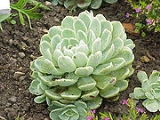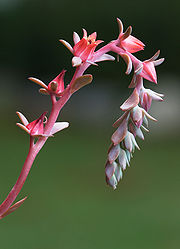
Echeveria
Encyclopedia
Echeveria ˌ is a large genus
of succulents in the Crassulaceae
family, native from Mexico
to northwestern South America
. The genus is named after the 18th century Mexican
botanical artist Atanasio Echeverría y Godoy
. Many of the species produce numerous offsets
, and are commonly known as 'Hen and chicks
', which can also refer to other genera such as Sempervivum that are significantly different from Echeveria.
Many Echeveria species are popular as garden
plant
s. They are drought
-resistant, although they do better with regular deep watering and fertilizing. Most will tolerate shade and some frost
, although hybrid species
tend to be less tolerant. They can be propagated easily by separating offsets
, but may also be propagated by leaf cuttings, and by seed
if they are not hybrids. Echeverias are polycarpic
, meaning that they may flower and set seed many times over the course of their lifetimes.
Most lose their lower leaves in winter; as a result, after a few years, the plants lose their attractive, compact appearance and need to be rerooted or propagated. In addition, if not removed, these shed leaves may decay, harboring fungus
which can then infect the plant.

Genus
In biology, a genus is a low-level taxonomic rank used in the biological classification of living and fossil organisms, which is an example of definition by genus and differentia...
of succulents in the Crassulaceae
Crassulaceae
Crassulaceae, or the orpine family, are a family of dicotyledons. They store water in their succulent leaves. They are found worldwide, but mostly occur in the Northern Hemisphere and southern Africa, typically in dry and/or cold areas where water may be scarce...
family, native from Mexico
Mexico
The United Mexican States , commonly known as Mexico , is a federal constitutional republic in North America. It is bordered on the north by the United States; on the south and west by the Pacific Ocean; on the southeast by Guatemala, Belize, and the Caribbean Sea; and on the east by the Gulf of...
to northwestern South America
South America
South America is a continent situated in the Western Hemisphere, mostly in the Southern Hemisphere, with a relatively small portion in the Northern Hemisphere. The continent is also considered a subcontinent of the Americas. It is bordered on the west by the Pacific Ocean and on the north and east...
. The genus is named after the 18th century Mexican
Mexico
The United Mexican States , commonly known as Mexico , is a federal constitutional republic in North America. It is bordered on the north by the United States; on the south and west by the Pacific Ocean; on the southeast by Guatemala, Belize, and the Caribbean Sea; and on the east by the Gulf of...
botanical artist Atanasio Echeverría y Godoy
Atanasio Echeverría y Godoy
Atanasio Echeverría y Godoy was an 18th century Mexican botanical artist and naturalist. He accompanied Martin de Sessé y Lacasta and Mariano Mociño Suárez de Figueroa in their expedition through Mexico, with the goal of compiling a great inventory of fauna and flora of the country.Because of...
. Many of the species produce numerous offsets
Offsets
In botany and horticulture Offset is a term used to describe a small virtually complete daughter plant that has been naturally asexually produced on the mother plant. They are clones , meaning that they are genetically identical to the mother plant. In the plant nursery business and gardens they...
, and are commonly known as 'Hen and chicks
Hen and chicks
thumb|right|240px| Jovibarba globifera showing larger mother plants and smaller, globe-shaped [[offsets]] .thumb|right|240px| Sempervivum tectorum...
', which can also refer to other genera such as Sempervivum that are significantly different from Echeveria.
Many Echeveria species are popular as garden
Garden
A garden is a planned space, usually outdoors, set aside for the display, cultivation, and enjoyment of plants and other forms of nature. The garden can incorporate both natural and man-made materials. The most common form today is known as a residential garden, but the term garden has...
plant
Plant
Plants are living organisms belonging to the kingdom Plantae. Precise definitions of the kingdom vary, but as the term is used here, plants include familiar organisms such as trees, flowers, herbs, bushes, grasses, vines, ferns, mosses, and green algae. The group is also called green plants or...
s. They are drought
Drought
A drought is an extended period of months or years when a region notes a deficiency in its water supply. Generally, this occurs when a region receives consistently below average precipitation. It can have a substantial impact on the ecosystem and agriculture of the affected region...
-resistant, although they do better with regular deep watering and fertilizing. Most will tolerate shade and some frost
Frost
Frost is the solid deposition of water vapor from saturated air. It is formed when solid surfaces are cooled to below the dew point of the adjacent air as well as below the freezing point of water. Frost crystals' size differ depending on time and water vapour available. Frost is also usually...
, although hybrid species
Species
In biology, a species is one of the basic units of biological classification and a taxonomic rank. A species is often defined as a group of organisms capable of interbreeding and producing fertile offspring. While in many cases this definition is adequate, more precise or differing measures are...
tend to be less tolerant. They can be propagated easily by separating offsets
Offsets
In botany and horticulture Offset is a term used to describe a small virtually complete daughter plant that has been naturally asexually produced on the mother plant. They are clones , meaning that they are genetically identical to the mother plant. In the plant nursery business and gardens they...
, but may also be propagated by leaf cuttings, and by seed
Seed
A seed is a small embryonic plant enclosed in a covering called the seed coat, usually with some stored food. It is the product of the ripened ovule of gymnosperm and angiosperm plants which occurs after fertilization and some growth within the mother plant...
if they are not hybrids. Echeverias are polycarpic
Polycarpic
Polycarpic plants are those that flower and set seeds many times before dying....
, meaning that they may flower and set seed many times over the course of their lifetimes.
Most lose their lower leaves in winter; as a result, after a few years, the plants lose their attractive, compact appearance and need to be rerooted or propagated. In addition, if not removed, these shed leaves may decay, harboring fungus
Fungus
A fungus is a member of a large group of eukaryotic organisms that includes microorganisms such as yeasts and molds , as well as the more familiar mushrooms. These organisms are classified as a kingdom, Fungi, which is separate from plants, animals, and bacteria...
which can then infect the plant.
Selected species

|
Echeveria setosa Echeveria setosa, commonly known as the Mexican fire cracker or the firecracker plant, is a member of the Crassulaceae family. It blooms from early to late April with bright red and yellow flowers. It is native to Mexico and is common throughout Puebla. They grow to about 3-6in in... Rose & Purpus |
Cultivars
- Echeveria agavoides cv. 'Ebony'
- Echeveria agavoides cv. 'Lipstick'
- Echeveria agavoides cv. 'Red'
- Echeveria agavoides cv. 'Victor Reiter'
- Echeveria pulvinata cv. 'Oliver'
- Echeveria cv. 'Arlie Wright'
- Echeveria cv. 'Black Prince'
- Echeveria cv. 'Blue Heron'
- Echeveria cv. 'Dondo'
- Echeveria cv. 'Doris Taylor' (Woolly Rose)
- Echeveria cv. 'Hoveyi'
- Echeveria cv. 'Lola'
- Echeveria cv. 'Opalina'
- Echeveria cv. 'Painted Lady'
- Echeveria cv. 'Ruberia'
- Echeveria cv. 'Set-Oliver'
- Echeveria cv. 'Tippy'
- Echeveria cv. 'Wavy Curls'
Formerly in Echeveria
- Dudleya anthonyi (as E. anthonyi)
- Dudleya arizonica Rose (as E. arizonica (Rose) Kearney & Peebles)
- Dudleya attenuata (as E. attenuata and E. edulis var. attenuata)
- Dudleya caespitosaDudleya caespitosaDudleya caespitosa is a succulent plant known by several common names, including Sealettuce, Sand lettuce, and Coast dudleya. It is endemic to California, where it grows along the coastline in the southern half of the state....
(as E. californica, E. cotyledon, E. helleri, and E. laxa) - Dudleya candida (as E. candida)
- Dudleya cultrata (as E. cultrata)
- Dudleya cymosaDudleya cymosaDudleya cymosa is a succulent plant known by the common name Canyon live-forever. The plant is found in rocky areas in the low elevations of California and southern Oregon mountains.-Description:...
(Lem.) Britton & Rose (as E. cymosa Lem.) - Dudleya edulisDudleya edulisDudleya edulis is a succulent plant known by the common name fingertips. This plant is native to Southern California and Baja California, where it grows in rocky areas of the coastal and the inland Peninsular Ranges mountains.-Description:...
(as E. edulis) - Dudleya pulverulenta ssp. pulverulentaDudleya pulverulentaDudleya pulverulenta is a succulent plant known by the common names chalk lettuce and chalk liveforever.-Distribution:This dudleya is native to the southwestern United States and northern Mexico, where it is found in steep open rocky areas in coastal and inland mountains and desert foothills, such...
(as E. argentea and E. pulverulenta) - Dudleya saxosa ssp. collomiaeDudleya saxosaDudleya saxosa is a succulent plant known by the common name Panamint liveforever. This dudleya is native to the rocky slopes of the Peninsular Ranges and the sky islands in Mojave Desert mountains, such as the Panamint Range, in Southern California, and in Baja California and...
(as E. collomiae) - Graptopetalum paraguayenseGraptopetalum paraguayenseGraptopetalum paraguayense is a species of succulent plant in the jade plant family, Crassulaceae, that is native to Tamaulipas, Mexico. Common names include Mother-of-pearl-plant and Ghost plant....
(N.E.Br.) E.Walther (as E. weinbergii hort. ex T.B.Sheph.) - Pachyveria clavifolia (as E. clavifolia)

